In the process of sewage dredging, poisoning and asphyxiation accidents are more likely to happen because of some reasons such as toxic and harmful gases, irregular operation of workers and lack of safety awareness. How to avoid the occurrence of poisoning and asphyxiation accidents in sewage dredging? Need to master the correct method of cleaning the sewage tank.
Correct dredging steps and safety precautions
1, before cleaning the cesspool, should close the valve of the sewage inlet, and drain the pool of sewage, keep natural ventilation for more than 24 hours. If you have conditions, mechanical cleaning is preferred.
2, the staff under the pool need to be at least 18 years old, and healthy, sober. People with respiratory, cardiovascular, allergies or skin allergies, as well as women are not allowed to engage in this type of work.
3, for cesspool cleaning operations, must fill out the “cesspool cleaning work orders. Designated by the person responsible for safety on-site safety personnel. Work orders must be made by the site safety personnel to clean the technical and safety briefings, the two sides should be in the “cesspool cleaning work orders” signed.
4, the pool operation must have on-site safety personnel present throughout the supervision of the implementation of security measures, the designation of more than two guardians.
5, under the pool personnel must wear the appropriate protective equipment (gloves, helmets, safety belts, safety ropes, carry a good oxygen tank and toxic gas alarms), by the site safety officers to check the safety measures before the operation.
6、Before going into the pool, a multi-functional gas detector must be used to measure and analyze the harmful gases in the pool. Only after determining that the hazardous gas has not exceeded the alarm limit, the safety officer will be responsible for supervision on site, and at the same time report to the first responsible person for safety for signature before the operation of the pool.
7、If the gas detector alarms during the detection process, it means that there are harmful gases in the pool and the concentration exceeds the standard. At this time, you need to use the blower to force ventilation for 15 minutes, and then use the gas detector to test. If the detection, the dangerous gas does not exceed the standard alarm is implemented in accordance with Article 6.
8、If the alarm is still exceeded by the gas detector after the blower is used for mechanical ventilation, the competent safety department should be notified immediately to send someone to the site to check the safety measures. Then, after the factory manager in charge of production signs and agrees, wear gloves, helmet, safety belt, safety rope, isolation breathing mask, before the pool operation, and do the pool operation records, the pool operation time shall not exceed 30 minutes.
9、After entering the pool, the tools and accessories used for dredging must be lifted and picked up by the tool bag, and throwing is strictly prohibited. There must be no stones, bricks and other objects that may cause injury within one meter around the operation well. Pool personnel should also do all the safety work for the pool personnel.
10, in the construction work area on the ground to delineate the exclusion zone, and hang construction work signs to prevent idle people from entering, the pool set up a safety ladder.
11、When working in the pool, any fire and smoke are strictly prohibited, and no flammable and explosive items are allowed to be brought into the pool for work. If fire work is needed and fire conditions are available, ventilation equipment must be used and fire-fighting equipment must be equipped, and a fire permit must be issued by the competent safety department before working in the pool.
12、If there is combustible gas in the dredging pool, the operator shall not use any open flame lighting and non-explosion-proof equipment in the space.
13, production and management units do not have the conditions of cleaning operations, the project should be contracted to have the appropriate qualifications of the construction unit, signed a contract and production safety agreement.
14, if the cleaning operation for a long time, the operator should take turns to go down the pool, such as pool operators appear dizzy, leg weakness, breath, nausea and other discomfort, should immediately leave the pool, to a well-ventilated area to rest.
15, cleaning operations, site safety and supervision personnel must adhere to their posts, focus, not engaged in other operations, keep in touch with underground operators, pay attention to observe, identify the state of underground workers, timely detection of problems, to avoid safety accidents.
16、Operation danger occurs, should immediately rescue the operator to leave the scene rescue, while notifying the competent safety departments and relevant leaders.
Second, accident first aid measures

When dredging operation, if there is a harmful gas poisoning accident, such as hydrogen sulfide, ammonia, etc., what necessary first-aid measures should we take?
1, hydrogen sulfide poisoning first aid treatment: quickly transfer the patient from the poisoning site to the fresh air, and remove the foreign matter in the patient’s mouth and contaminated clothing, immediately give the patient oxygen and untie his tie, trouser belt, etc., to keep the patient’s airway open, and call 120 emergency telephone for help. If the patient’s heartbeat and breathing stop, rescuers should immediately perform artificial respiration (it is appropriate to use thoracic extrusion artificial respiration, avoid using mouth-to-mouth artificial respiration, as a last resort, and the patient interval several layers of water wet gauze) and extracorporeal cardiac extrusion to enhance respiratory capacity, until sent to the hospital.
2、First aid treatment for ammonia poisoning: quickly move the patient away from the poisoning site to fresh air, remove foreign matter from the mouth and contaminated clothing, thoroughly rinse the contaminated eyes and skin, and call 120 emergency number for help at the same time, untie and trouser belt to keep the respiratory tract unobstructed.
3、External rescue